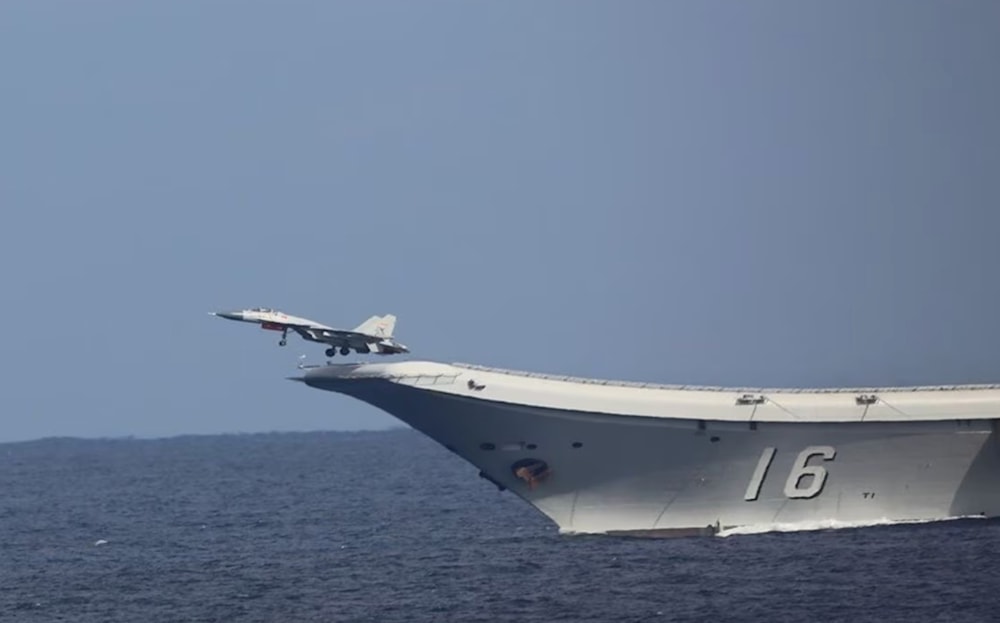China warns US South China Sea ops risk deadly accidents: Global Times
Senior Colonel Zhang Xiaogang accused the US and its partners of escalating tensions through repeated intrusions into areas under Chinese jurisdiction.
-

Carrier-based fighter jet "J-15" takes off from China's aircraft carrier "Liaoning" over the Pacific Ocean off Okinawa Prefecture (Japan MoD)
The Globes reported on Tuesday that while the United States has maintained a high operational tempo in the South China Sea, its military deployments in the region have leveled off over the past year, according to a new report by a Chinese think tank. The findings come amid rising concerns in Beijing over what it sees as increasingly hazardous US activity near its borders.
The Beijing-based South China Sea Strategic Situation Probing Initiative (SCSPI) released the report detailing US military operations in 2024, noting that although Washington sustained high-intensity activities—ranging from reconnaissance and Taiwan Strait transits to joint drills and strategic presence—it has now reached a "peacetime peak." The report pointed to an "increment bottleneck" in platform numbers and global distractions such as the Red Sea crisis as limiting further expansion.
Despite a plateau in aerial activity—approximately 1,000 reconnaissance sorties in 2024, roughly on par with previous years—SCSPI observed a marked increase in US maritime reconnaissance. It also highlighted the Philippines' growing role as a key logistical hub for American operations.
#China's military expelled three Philippine aircraft that illegally entered the airspace near China's #Nansha Qundao in the #SouthChinaSea on Thursday, according to a military spokesperson.
— China News 中国新闻网 (@Echinanews) February 21, 2025
The Chinese People's Liberation Army (PLA) Southern Theater Command tracked and warned… pic.twitter.com/pqzucJEzVd
Chinese military affairs expert Zhang Junshe warned that while the US may be reaching a deployment ceiling, the current intensity of its military activity still poses serious dangers. "The US' highly intensive military activities including close-in reconnaissance could result in aerial and maritime accidents," he cautioned, adding that US forces are experiencing strain. Zhang cited past incidents such as the October 2021 collision involving the USS Connecticut and the January 2022 F-35C crash on the USS Carl Vinson as examples of the risks involved.
He also noted that the US' dispersed military commitments in Europe and the Middle East have thinned its available resources in the Indo-Pacific. "The US has dispersed military resources to Europe and the Middle East, so it has had limited equipment to further enhance activities in the South China Sea," Zhang said.
Zhang added that if US forces continue approaching too close to Chinese territory, the potential for conflict will increase. "Accidents are also likely to happen if the US military approaches too close to Chinese territories, forcing the Chinese side to track, monitor and drive them away when necessary," he warned.
Read more: US Navy faces crisis as only 13 of 32 amphibious ships ready for duty
China's Ministry of National Defense echoed this concern. Senior Colonel Zhang Xiaogang accused the US and its partners of escalating tensions through repeated intrusions into areas under Chinese jurisdiction. "The US and its allies and partners' vessels and aircraft have conducted close-in harassment and provocation, illegally trespassed into Chinese territorial waters or sea and airspaces under Chinese jurisdiction, maliciously disturbed normal training activities by the Chinese side, irresponsibly made reckless maneuvers," he said during a press conference in September 2024.
He added, "Such actions seriously undermined China's sovereignty and security interests, seriously harmed safety of personnel from both sides, seriously sabotaged peace and stability in the region." Concluding, Zhang said, "These fully show that the US side is the true provocateur, disturber and destroyer."

 3 Min Read
3 Min Read








